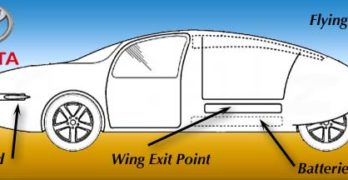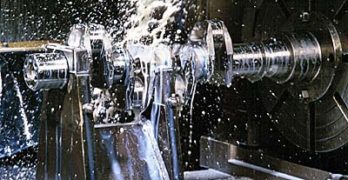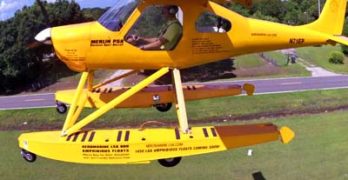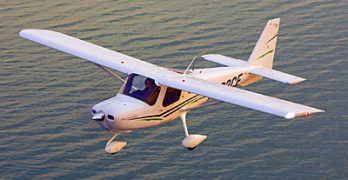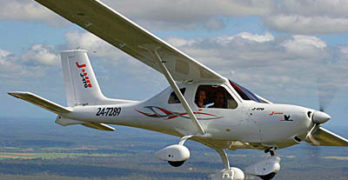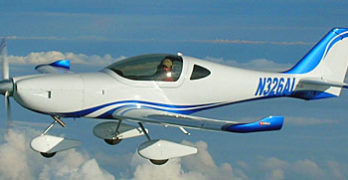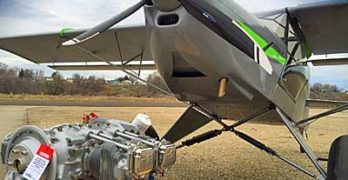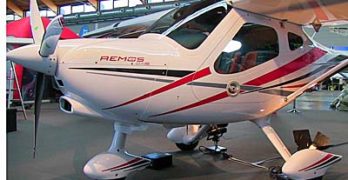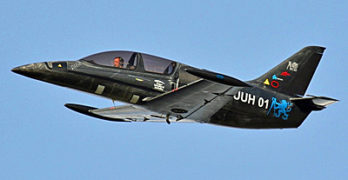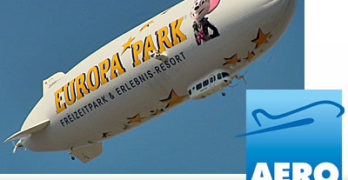Maybe you haven’t heard enough about electric-powered aircraft, flying cars, and automobiles on autopilot (presuming you’re aware of Tesla’s fatal accident in May). How about a shape-shifting aerocar? Huh?! I know it sounds rather crazy but Toyota, being the world’s largest car manufacturer, is not a name to be dismissed when they may choose to delve into the flying car business… twice, in a few months!
Nope, I’m not kidding. The Japanese car company was awarded a patent for a “Shape Morphing Fuselage for an Aerocar.” The illustrations — typical patent artwork — might fool you. This is not some 1930s silliness. The U.S. Patent office published this very recently, on June 23rd, 2016.
Perhaps it’s no more than a publicity generator, much like Amazon’s drone delivery aircraft — about which, by the way, Amazon claims to be sincere. Or, maybe Toyota is afraid Terrafugia might beat them to an interesting market, something like Tesla did to the big boys of auto manufacturing.
Search Results for : flight design ct
Not finding exactly what you expected? Try our advanced search option.
Select a manufacturer to go straight to all our content about that manufacturer.
Select an aircraft model to go straight to all our content about that model.
Jabiru Gets an “OK” from Australian CASA
It doesn’t often happen this way. When media reporters get hold of a story that casts a company or person in a bad light, this generates headlines. The results can be disastrous for that company or person. However, if the initial article turns out to be overstated, a followup report does not always earn publication. News organizations don’t gain subscribers or advertisers by saying, “All is OK now.”
Perhaps this was the situation with Jabiru… the engine side of the house, not the airframe side. As you can read in our earlier report, Jabiru was taken to task for some problems down under. You should judge for yourself.
“I hope people who read [CASA’s] report get the main message that well-maintained Jabiru engines were not a problem but sloppy maintenance did them in,” wrote Jabiru North America boss, Pete Krotje. “CASA does not mention the group of eight flight schools where most of the problems arose and that the same maintenance company did their maintenance.” He ventured further saying, “I can’t imagine that the FAA would take steps similar to CASA’s limitations without knowing the source of the problem.”
Pete wrote, “Limitations have been lifted on engines that have been maintained according to the Jabiru manual and have complied to the ‘significant’ Jabiru service bulletins & service letters.” He expressed that, “It is a real round about way of saying that poor maintenance practices are the real cause of Jabiru engine malfunctions.” Like it or not, aircraft — like houses, autos, RVs, boats, well… pretty much everything — require regular and proper maintenance.
Summertime Float Flying: Now You Can Afford It
It’s summer. It’s hot. The water beckons. Yet, you’re a pilot. How do you enjoy both? Get a seaplane, preferably a Light-Sport or light kit seaplane. You have several choices. The trouble is that any seaplane is priced well above landplanes of similar configuration. Some LSA seaplanes smash through the $200,000 barrier. That may represent a fair value for what you get but it exceeds the budget of many recreational pilots. How about $55,000 to $65,000? That sounds better, doesn’t it?
Runway testing and cross country trials of the float-equipped Merlin PSA is complete. Aeromarine LSA owner Chip Erwin reports performing stalls, turns, climb, and cruise tests, each of which passed his criteria, although he continues in trials. The floatplane Merlin has not yet entered the water but that will happen in days after Chip finishes his initial wringing out of the float version. These floats are amphibious so land trials made sense at first.
LSA “Market Failing” Statement and My Response
This month, I had an email exchange with a leader in aviation. I debated if I should reply. For a time, I did not but I felt compelled given the person’s stature. I was driven to attempt informing those this individual might influence. I further pondered if I should write an article about it, but I feel one must confront potential errors if for no other reason than to promote healthy dialogue.
I am not to going reveal with whom I had this exchange. Personality isn’t important to the discussion but this person expressed what I suspect represents the opinion of a fair share of general aviation pilots, at least those who have not fully explored recreational aircraft such as LSA, or light kits, or ultralights.
The following comes from our second round of email. In the first, the writer referred to LSA “market failings” and I asked what was meant.
Jabiru 170D Returns, Offering Excellent Value
Given that the Sport Pilot / Light-Sport Aircraft sector is only a dozen years old (announced July 2004 with the first Special LSA approval in April 2005), Jabiru North America seems almost an old timer with 17 years of business in their corporate logbook. During those years, the onetime Wisconsin company relocated to Shelbyville, Tennessee.
At Sun ‘n Fun 2016, Jabiru North America announced their new J-170D model.
Australia’s most popular LSA trainer has been noticeably improved and updated. Among other improvements, the down-under engineers redesigned the vertical stabilizer, giving it a more swept stance and a wider airfoil shape, which makes the aircraft more stable and require less rudder input than before, according to Jabiru. They believe this enhanced two seater will make an even better flight instruction airplane.
“The [previous] J170-SP has been a great trainer here in the USA, with its stout landing gear, stable handling, and fuel economy of less than 4 gallons per hour in daily use,” said Pete Krotje, President of Jabiru North America.
Sun Catches Lightning – Sun Flyer Rollout
Recently, aviation titles chronicled the rollout of Sun Flyer’s prototype electric powered airplane. To careful observers, the aircraft might appear somewhat familiar. Good eyes, folks. The prototype was built for Aero Electric Aircraft Corporation by Arion Aircraft. The beautiful sweeping lines of the Sun Flyer are nearly identical to the Lightning LS-1.
The one notable difference — and in fact this is the whole story — is the electric motor up front allowing Sun Flyer to look even a bit more streamlined than the dashing outline of Lightning. This is a first article aircraft as photos don’t yet show any solar cells on the wings, as promised by Aero Electric.
Regardless of how AEAC develops Sun Flyer down the line, it was wonderful to see them linking up with Arion Aircraft whose LSA and kit models have been admired for their gracefully smooth shape for some years.
Invasion of the Titan; More LSA Go Big Power
In my many years in aviation, I’ve learned this about light aviation pilots: If 80-horsepower is good, then 100-horsepower is better, and even more is best of all. It explains why interest was so high when Rotax announced their new 915iS that will provide 135 horsepower. It also illustrates why the 180 horses of the Titan X-340 is succeeding in the Light-Sport Industry.
Interest from LSA producers started with CubCrafters adopting the engine several years ago. When that company’s boss, Jim Richmond, held a press conference at Sun ‘n Fun, the reception was somewhat cool. Of ten persons in the audience, only four of us were journalists. The other six (yes, 6!) people were from FAA. No wonder, perhaps, as ASTM standards at the time brought questions to mind regarding the use of such a powerful engine. Those standards have since been modified somewhat.
Indeed, the western producer instructed users that the engine could only be used at full power for takeoff or climbing, but otherwise had to be set to lower power.
Remos is Back and Scores at Aero 2016
Think back far enough in the still-fairly-new LSA sector and you should recall a time when one brand made some major impact on all of personal aviation. The company was Remos and their U.S. team amped up promotional activity to the level of full page ads in most of the biggest aviation magazines in aviation. By my casual estimate, Remos was spending north of $35,000 per month on splashy advertisements.
Remos also did an airplane giveaway with AOPA; the company was a seemingly unstoppable juggernaut. Prudent or not, you had to admire that the company pulled out the stops in an effort to become the main LSA brand. Such a no-holds-barred approach has worked for products in other industries. However…
Then the door of opportunity slammed shut. It was not that the advertising didn’t work. Certainly it did make the brand well recognized. However, by 2009 the global economy was in a tailspin.
You Wanna Be a Jet Pilot? Check out UL-39
When they introduced Light-Sport Aircraft FAA prohibited use of a jet engine. Looking at the photos nearby you can see that this airplane cannot pass must as a LSA. Or, wait! That’s no jet. It just pretended to be one at Aero Friedrichshafen 2016.
At my home airport (Spruce Creek Fly-in), I regularly see one or another full-size L-39 in various stages of being prepared for a new American owner. I was told that about 200 of these ex-Czech military jets are operating in the U.S. They are handsome, sleek, and fast-like-a-jet. Contrarily, the UL-39 is not as fast but neither should its cost of upkeep be anything close to a military jet.
We’re getting a bit ahead of ourselves. The UL-39 on display was a wonderful proof-of-concept aircraft that managed to engage nearly a generation of students in aeronautical engineering disciplines at the Czech Technical University in Prague.
My 4 Favorite Aircraft Seen at Aero 2016
I always love traveling to Aero Friedrichshafen because of the new aircraft I will see. We media types live for the new stuff (because it’s what we believe our readers or video watchers want to consume). I made my last dash through the hall on Saturday — Aero ran from April 20-23, 2016 — and I am now in Zurich, Switzerland awaiting my flight back to the USA.
I saw many aircraft worthy of closer examination. I will prepare articles on those and more detail about the ones below, too. Later on, some of my Aero videos will hit YouTube after some editing. While the memories are fresh, though, I want to give an early peek at four aircraft that grabbed my attention …and that of many others, judging from the challenge to get near them during opening hours. I present these in no particular order.
Zlin Savage Shock — Shock definitely created awe at Aero.
- « Previous Page
- 1
- …
- 75
- 76
- 77
- 78
- 79
- …
- 145
- Next Page »


